Wolverhampton-Hereford
I took a taxi to Wolverhampton (our bus service starts too late on a Saturday to be of help), a 'Virgin' London working to Birmingham New Street and then a 'West Midland Trains' service was supposed to take me to Hereford. The taxi worked, the short leg to Birmingham worked but the final segment proved 'interesting'.
I found the Class 172 Diesel Multiple Unit (DMU) which was to form the 08:50 to Hereford in platform 10. The unit was shut down and displaying a red tail lamp at each end but the Conductor had already arrived, opened the doors and passengers were boarding.
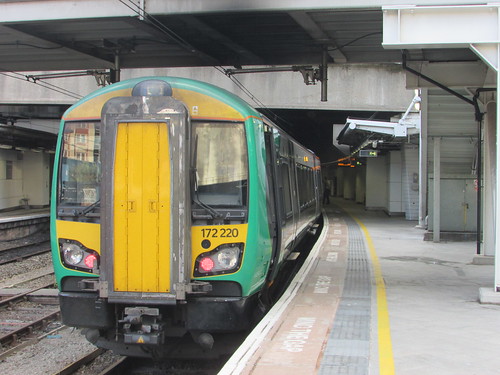
West Midland Railways: Birmingham New Street: Class 172 in platform 10, 28th July 2018.
The driver appeared, started the unit and we departed on time. The train slowly left New Street on the Down Gloucester line, passing through four tunnels (Holliday Street, Canal, Granville Street and Bath Row) before speed increased through Five Ways Station. We were due to stop at University Station, about two and a half miles from our starting point but suddenly the driver made a 'Full Service' brake application and we came to a rapid stop. 'What now?' I thought. I was sitting on the left (as I usually do, offering a limited view of passing signals) and could see no reason for our unscheduled halt. On the right of the train, clouds of smoke drifted by and passengers on that side started to take pictures with their mobile phones. Still puzzled, I got up, moved across and looked ahead on the right. I was quite started to see fierce flames on the heavily overgrown embankment.
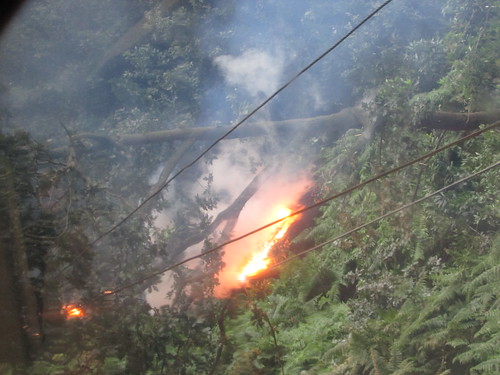
28th July 2018: Near University, a fallen tree on the embankment on the Up side had displaced the wires of the overhead traction system, producing a fairly spectacular fire.
The view from modern trains is not good and looking obliquely ahead through the double-glazed window unit was not ideal but it appeared that a tall tree on the embankment had fallen across the tracks and the return conductor, catenary wire and contact wire had all been pushed towards the ground by the weight of the tree. The main trunk was now horizontal, balanced across the overhead lines. The orange flames appeared to be the dry undergrowth burning but there was also a bright, white light in the fire suggesting that sustained arcing from the overhead system might still be occurring. As I watched the impressive display, there was a loud 'Whump', startling a number of passengers, and the white light ceased. I imagined this might be as the traction system finally 'tripped', or was intentionally discharged following a call on the radio from our driver. The orange flames continued and the young conductor announced that we were setting back a few yards to maintain a safe distance from the conflagration. The driver 'changed ends' and moved the train fifty yards or so back towards Birmingham New Street.
As we waited, I was impressed that, rather than resorting to the public address, the conductor worked his way through the 2-coach train advising passengers directly of his rather gloomy prediction that "we could be stuck here for hours". That seemed unduly pessimistic to me (we were only about two miles from Birmingham New Street Station) and, indeed, after perhaps ten minutes the conductor announced that we were returning to New Street. The driver set off 'wrong road' back the way we'd come but after a few hundred yards, an emergency crossover crossed us to the 'right road' and we continued under normal signalling back to New Street Station. We were were routed back into platform 10, where the colour light signal halfway along the platform beckoned us to the stop at the south end of the platform face. Birmingham New Street retains much of its complex network of approach routes, offering alternative ways of keeping trains moving when a line become unavailable. I anticipated that we'd continue our journey by taking the Up Derby as far as Grand Junction, diverging to St. Andrews Junction and then taking the Camp Hill line so as to regain our original route at Kings Norton. The Camp Hill line is not electrified, so that option was not available to the 'Cross City' service of Electrical Multiple Units (EMU) which provide a frequent commuter service to Longbridge and Redditch.
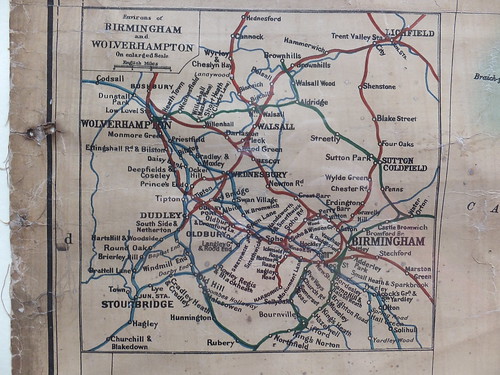
'Environs of Birmingham & Wolverhampton' from the 11th Edition of the Pre-Grouping 'Railway Map of England and Wales' published by W & A K Johnston.
Passengers who wanted stations to Kings Norton were advised to disembark and new passengers boarded. It was almost an hour since our initial departure so the new passengers had probably arrived for the next service. Still anxious not to give false hope to his passengers, the conductor announced that "at some point" our train would depart. Almost immediately, the signal cleared and the conductor ran to the 'back cab' to get the train away. As expected, we were routed to the Camp Hill line.
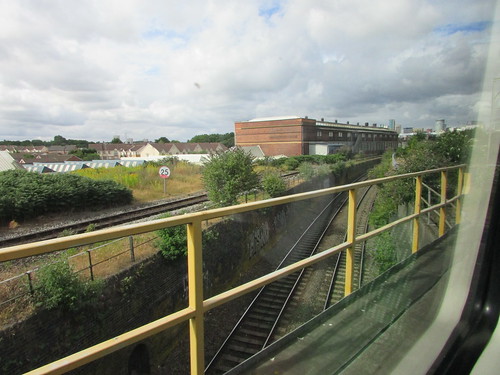
Flyunder near Grand Junction, Birmingham. L-R: Down Camp Hill, Down Derby, Up Derby, Up Camp Hill (on bridge), 28th July 2018.
At Kings Norton, we were back on the electrified route and each station we passed had an EMU waiting in the Up platform, unable to proceed further towards Birmingham until the catenary damage near University Station had been addressed.
I'd not been following the saga of the extension of electrification from Barnt Green (where the single-line branch to Redditch diverges), down the famous Lickey Incline to a new enlarged, remodelled and resignalled station at Bromsgrove. This was to have been completed in 2014 and the new 4-platform station certainly looked impressive. I discovered afterwards that the new, improved electric services were to start the very next day - Sunday 29th July 2018 - a mere four years late!
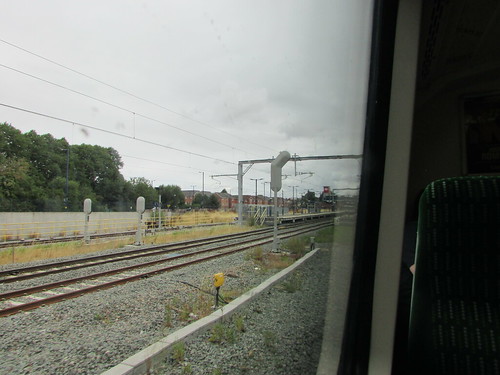
South end of the remodelled Bromsgrove station: 28th July 2018:
Two miles beyond Bromsgrove, we diverged right at Stoke Works Junction and, after four miles of single track, joined the double-track line from Kidderminster at Droitwich Spa Junction. Lower quadrant signals and a standard GWR design signal box (albeit with modern alterations) confirmed that we were now on former Great Western lines.
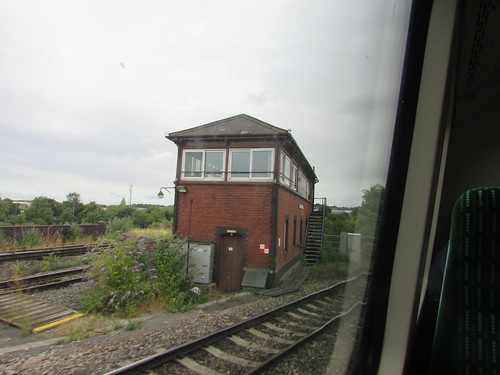
Worcester Area Rail: Droitwich Spa signal box 28th July 2018
As we continued our journey, the conductor announced that his Control had informed him that our late-running service would now terminate at Great Malvern and that passengers for stations beyond there should de-train at Worcester Foregate Street where road transport onwards would be made available. On our modern railway system (which a member of the Rail Delivery Group recently had the temerity to describe as "the envy of Europe") passengers, who are now called 'customers', are casually treated with contempt. Although the original reason for delay was unfortunate (although probably avoidable with better arrangements for periodic lineside inspection and maintenance), Control's concern was to seek to get the unit and crew back onto their scheduled 'diagram', by turning the train around short of its destination. The inconvenience to passengers didn't seem to feature in their calculations, as we discovered on our arrival at Worcester Foregate Street where station staff confirmed that there was no onwards road transport and we should simply wait for a following train to Hereford.
Since the following train was also running late, I had time to take some photographs around the station. Although at first sight it appears a conventional 2-track station with flanking platforms, the two lines form the southern apex of a triangle and two elderly, wooden, hand-painted signs at the southern ends of the platforms warn:-
CAUTION
TWO-WAY
working on
BOTH LINES
I assumed that the mix of upper and lower case was to fit the message in the available space.
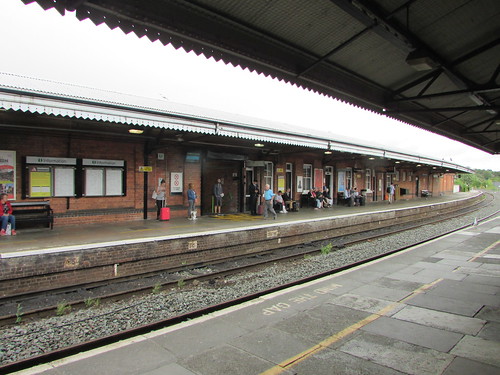
Worcester Area Rail: View from Worcester Foregate Street Platform 1 looking towards Rainbow Hill Junction, 28th July 2018.
Eventually, the following train for Hereford arrived, loaded up and set off southwards, passing over Foregate Street bridge which gives the station its name. The two parallel single lines are then carried over the 935 yard Worcester Viaduct and the River Severn before crossovers at Henwick Level Crossing signal box restore normal Up and Down running through Malvern Link and Great Malvern stations.
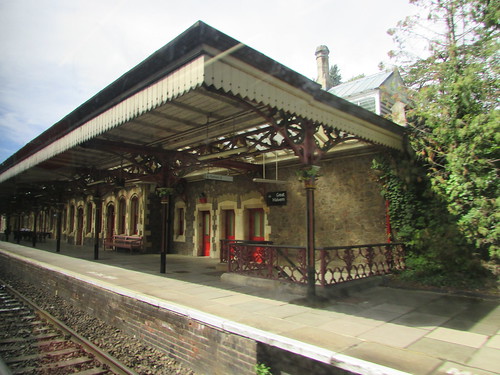 Worcester Area Rail: Great Malvern station Up platform, 28th July 2018.
Worcester Area Rail: Great Malvern station Up platform, 28th July 2018.
About one mile beyond Great Malvern station, at Malvern Wells signal box, the line singles through Colwall Tunnel (1536 yards) and Colwall station. After Ledbury Tunnel (1316 yards), Ledbury station has a passing loop but becomes single again before crossing over the 372 yard Ledbury Viaduct. Another 12 miles of single track leads to Shelwick Junction on the double-track Shrewsbury-Hereford Line. This junction is now remotely-controlled from Hereford, about 2-miles further on. My arrival at Hereford was 86 minutes late.
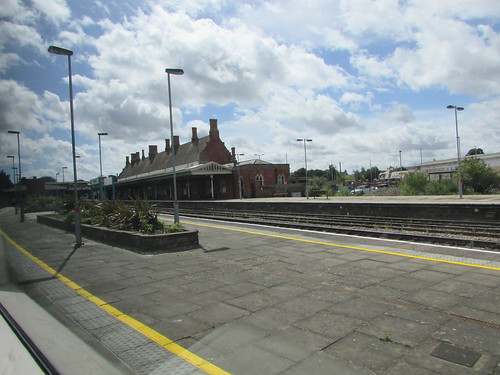
Hereford station buildings viewed from platform 1: 28th July 2018.
The 'Lionsmeet' event is described in the post here.
My return rail journey, via Shrewsbury, is described in the post here.
My pictures
Where necessary, clicking on an image above will display an 'uncropped' view or, alternately, pictures may be selected, viewed or downloaded, in various sizes, from one of the albums below:-
West Midland Railways.
Worcester Area Rail.
Shrewsbury-Hereford line (includes more pictures of Hereford station).
[Link to return journey added 11-Aug-2018, link to 'Lionsmeet' post added 26-Aug-2018]
